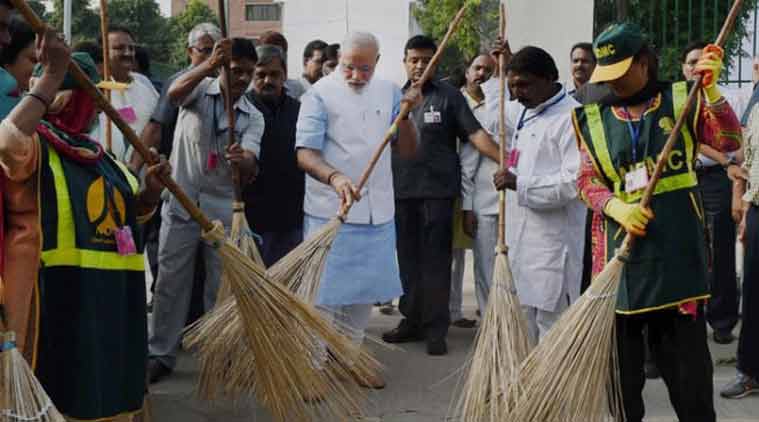A year of Swachh Bharat and it’s been no clean sweep. Here is why
Rankings released earlier show several major cities such as Mumbai, Delhi, Hyderabad, Patna, Lucknow, Jaipur among others fare poorly on the cleanliness scale.
 Narendra Modi wields a broom with NDMC workers to launch ‘Swachh Bharat Abhiyan’. (Source: PTI/file photo)
Narendra Modi wields a broom with NDMC workers to launch ‘Swachh Bharat Abhiyan’. (Source: PTI/file photo)
A review of the year-long progress of the five-year Swachh Bharat Mission suggests it fail to match the high-decibel campaigning that has been the trademark of the flagship mission launched by Prime Minister Narendra Modi on October 2, 2014.
So as to put an end to open defecation and adopt better solid waste management practices, the one-year target for urban areas was to finish constructing 25 lakh individual toilets, 1 lakh community and public toilets, achieve 100 per cent collection and transportation of waste in 1,000 cities and cent per cent processing and disposal of waste in 100 cities. Only 20-25 percent of the target in terms of toilet construction has been achieved while on the garbage management front, the results are even more abysmal. Rankings released earlier show several major cities such as Mumbai, Delhi, Hyderabad, Patna, Lucknow, Jaipur among others fare poorly on the cleanliness scale.
[related-post]
The government has claimed that it has performed far better in rural India having constructed more than 80 lakh toilets in this period. However, the numbers are not exactly an indicator of the success of the Swachh Bharat Mission alone as it includes toilets constructed under several ongoing schemes such as the National Rural Employment Guarantee Act and the Indira Awaas Yojana. Moreover, the ministries in charge of Defence, Civil Aviation, Human Resource Development, Railways and Health have not reported on the extent of success of the cleanliness drive in the institutions under them.
While explaining the not-so-satisfactory figures a year into the mission, the government’s official version is that their initial focus has been on a campaign to to induce behavioral change in people. While such a change is imperative, it can only happen if the required physical infrastructure is in place. For instance, it is a tall order to wish away open defecation or eradication of manual scavenging unless people have access to toilets that are serviced by municipal systems.
Likewise, merely attitudinal changes in people will not end the problem of garbage accumulation in our cities unless the complete chain of garbage management is in place: from separation of dry and wet waste at source to processing in landfills.
- 01
- 02
- 03
- 04
- 05






































